Categories: Electrician at home, Electric installation work
Number of views: 30716
Comments on the article: 1
How to upgrade the electrical panel in a private house
 Despite the fact that the regulatory requirements for the rules for operating electrical installations in residential buildings have changed a long time in the countryside, there are still many houses that are powered by the old TN-C circuit through an electric panel with an induction meter with an accuracy class of 2.5%, protected by fuses with fusible inserts. Such a scheme has long required modernization.
Despite the fact that the regulatory requirements for the rules for operating electrical installations in residential buildings have changed a long time in the countryside, there are still many houses that are powered by the old TN-C circuit through an electric panel with an induction meter with an accuracy class of 2.5%, protected by fuses with fusible inserts. Such a scheme has long required modernization.
Even the reconstruction of overhead lines by the power supply organization and the replacement of obsolete open wires with self-supporting insulated models does not always push owners to change the electrical circuit.
Old electrical panels are now operating at the limit of their capabilities and do not fully provide electrical safety for residents and equipment.
To perform the modernization of the electrical panel in a private house, it is necessary to take into account a number of factors:
-
the system of the applicable grounding circuit of electrical equipment and the presence of lightning protection, which determine the design of the input device;
-
type and functions of the electric meter;
-
choose the necessary protection;
-
take into account the dimensions.
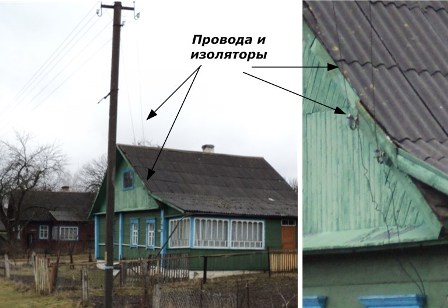
Entrance to the house from the support of VL-0.4 kV
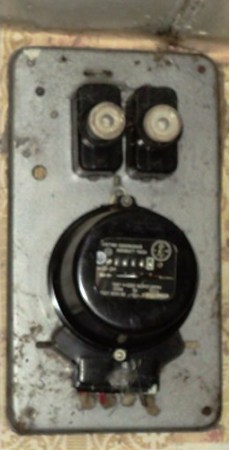
Old fuse box
Before the start of modernization, it is necessary to determine the loads of all electrical devices, summarize and analyze them in order to create a small power reserve. A private house can be made as a one-story or multi-story building with a different number of outbuildings, equipped with all kinds of electrical equipment and appliances. All consumers should be well protected and their loads taken into account.
Selection of introductory switchgear for a private house - this is a big separate topic, in which you should take into account the type of branch, its design and thickness of the wires, methods for splitting the PEN conductor, performed only in the ASU, and a number of other factors.
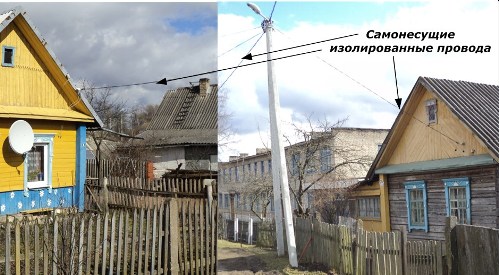
Entering the house from the support of VL-0.4 kV wires with SIP wires
How to choose an electric meter
Among the many models of metering devicescommercially available, it can be difficult to select the most suitable design. For practical use, it is important to consider the following parameters:
-
the number of phases - in recent years there has been a tendency to increase the number of three-phase inputs;
-
maximum permissible loads;
-
sizes
-
mounting methods - using a DIN rail is preferable;
-
the possibility of using multi-tariff modes;
-
price;
the ability of a local Energonadzor enterprise to carry out initial and periodic verification.
Pay attention to the last paragraph, otherwise the representatives of Energonadzor simply refuse to use the meter you bought.
How to choose protective devices for the electrical panel
It is difficult to give universal recommendations on the protection of electrical equipment for a modern private house, however, it is conditionally possible to make a separation into mandatory and additional devices.
In the most simplified version, you will need to use:
-
an introductory circuit breaker that can completely remove the load from the equipment of the house during manual or automatic operation;
-
additional machines for disconnecting consumers allocated to separate groups.
Introductory machine
According to existing rules, its location is usually chosen before the electric meter to ensure the possibility of its safe replacement and verification. However, this option allows the theft of electricity due to unauthorized connection of additional wires to the output terminals of the machine.
Therefore, the energy supply organization can offer one of the options:
-
restriction of access and sealing of all contacts of the machine with their brands;
-
powering the electric meter directly from the OHL branch through an input switchgear.
In the latter case, theft options are sharply reduced, especially when connecting electricity to self-supporting insulated wires. But when replacing the meter, it will be necessary to remove the voltage from the supply line.
Therefore, it is better to coordinate the issue of the location of the introductory machine, as well as the model of the electric meter before the start of the modernization of the electrical panel, with the enterprise of Energonadzor.
Group circuit breakers
Typically, home electrical consumers are divided into blocks at their location, for example:
-
lighting devices by rooms;
-
kitchen equipment (microwave, dishwasher, cooker hood, refrigerator, etc.);
-
a fan, a computer and office appliances in the office;
-
start-up device, electric tool and heating devices in the garage;
-
and other groups.
Each instrument cluster is able to create a specific load. Under it, the nominal value of the corresponding circuit breaker.
Additional but necessary protective devices
Fire RCD
The purpose of the protection is explained by its name. This means that under unacceptable loads, a breakdown in insulation will lead to the appearance of a leakage current to the ground, which will “feel” the RCD and remove the voltage from the electrical circuit, preventing a fire. For this protection, the installation location is usually chosen immediately after the counter to cover the entire area of the house and a 300 milliampere setpoint is assigned.
Voltage monitoring relay
Despite the measures taken to improve the reliability of power supply, the quality of electricity does not always meet the declared standards. No one is safe from voltage increase during burnout or loss of zero in the 0.4 kV network.
In this case voltage monitoring relay reliably disconnect your home from a sudden emergency and automatically return the circuit to its original state after restoring the network to its default settings. To do this, it is installed immediately after the counter.
RCD and difavtomat
Ouzo and difavtomat protect equipment and people from leakage currents resulting from insulation failures. A properly configured RCD will save a person from receiving electrical injuries and will preserve his health in the event of a fault in the wiring.
The installation location of the residual current device is selected in front of the group circuit breaker, which simultaneously protects the RCD from possible short-circuit currents in the circuit. Since the difavtomat combines the functions of an RCD with an automatic machine, its use saves space in the home shield.
Schematic diagrams of the electrical panel in a private house
In order to save material resources, it is allowed to use a knife switch or a switch of the corresponding power, instead of the opening main automatic machine, as quite often arrived earlier. But in this case, it is necessary to more carefully analyze the capabilities of the defenses and how to duplicate them.
Variant of execution of the circuit section for connecting electric meter after the opening circuit breaker in the apartment panel is shown in the figure. It shows both single-phase and three-phase circuitry, taking into account the PE-conductor wiring.
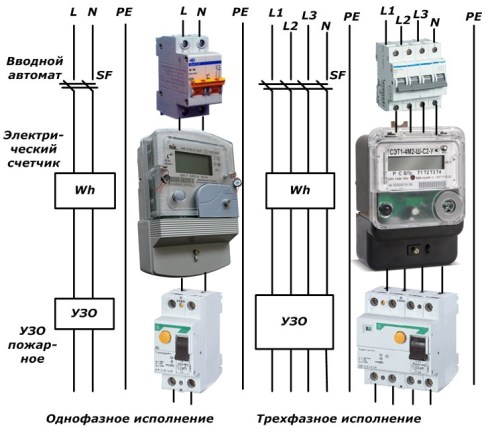
After a fire RCD or an electric meter, voltage is supplied to groups of consumers combined in blocks at the location or functional purpose. For them, power is supplied through an RCD configured to a sensitivity setting of 30 mA for ordinary rooms and 10 mA for wet or damp.
Properly dividing consumers into groups is the main difficulty in designing a shield. In this case, you must follow the rules:
-
separate lighting lines and power circuits;
-
unite consumers by main types of premises;
-
a separate circuit to power equipment operating: in conditions of high humidity; briefly forming large loads (washing machine, water heater, heating boiler ...);
-
street lighting and power circuits; electrical equipment of the garage and utility buildings.
Each group, depending on the created load, selects the protection settings and selects wires for mounting the circuit. For example, for lighting circuits made with 1.5 mm copper wire2, the power of the devices should be limited to 3.5 kW, and for power circuits with a copper cross section of 2.5 mm2 - 5.5 kW.
For the selection of wires and shields it is convenient to use programs for an electrician.

Schematic diagram of the formation of line groups for consumers
A residual current device that monitors a large number of working consumers can often trip. This will complicate troubleshooting and circuit maintenance. The RCD is connected in series with the circuit breaker, and its rated current is selected according to the load of the machine, equal to or one step higher than the total current protection.
The diagram shows that the phase conductor after the RCD is distributed through linear circuit breakers of type "B" or "C" and sent to consumers directly.
The working zero N is not passed through the machines, connected directly to the house wiring diagram. For consumer group No. 2, the option of forming a zero bus N using an additional terminal block is shown.
The use of difavtomat is demonstrated by the consumer group No. 3. Here the circuit breaker is not needed. However, a misdirect machine with incorrect selection can be falsely triggered when switching on switching power supplies, for example, on a computer.
The wiring of the PE conductor is carried out through a specially formed PE bus.
Basic requirements for the electrical panel
The choice of the shield model can be done after completing the design of the electrical circuit of the house, taking into account the complete determination of the number of switching and protective devices. At the same time, a small margin should be created for possible future connections of additional equipment, for example, electric pumps, gate drives or emergency lighting.
Usually, the space inside the shield quickly fills up over time, and sometimes the owners even deliver an additional electrical panel.
The location of the shield during the modernization of the circuit should be selected taking into account the convenience of its operation and quick release of voltage from the circuit at home. If replacement of the wiring is not planned, then a new switchboard is placed near the dismantled one to reduce the amount of installation work.
The access of children, pets and unauthorized persons to the shield must be limited by a lock locked with a removable key, which is stored in a specially designated place.
Modern switchboards have a DIN rail inside, on which all equipment is conveniently and securely mounted. This saves space.
On the flap door in front of the electric meter, it is convenient to make a window with a transparent insert for reading readings without opening the lock.
All shield equipment must be clearly signed. Use of fading inks, felt-tip pens, or printer powders is not recommended. Labels must be retained for a long time.
Often with a compact arrangement of switching devices, there is not enough space for tags. In this case, it is allowed to mark the equipment with clearly visible numbers with a detailed decoding of their names and purpose on a separate sheet stored on the door or other accessible place.
Correct labeling and a detailed description of the constituent elements of the shield in the future will save a lot of time, nerves and help to quickly eliminate any malfunctions in the network.
Storage inside the safety poster “Do not turn on! Work on the line! ” will help in repairing the circuit to exclude human exposure to voltage.The poster should always be hung on the disconnected levers of the machines during any work.
Features of installation of equipment in the electrical panel
The automatic devices are mounted on a DIN rail so that the arcing chamber (grill, plates) is on top (the lever is turned up). With this arrangement, the most favorable mode is created for arc breaking during shutdown, which saves a work resource of about 25%. Incorrect placement of the machine reduces its life.
The power supply to the machines is performed from above, and the load tap is from below. Some manufacturers, such as Siemens or Legrand, allow you to supply power arbitrarily. But in the switchboard everything should be connected in the same way - otherwise, during the work of electricians, errors and even cases of damage to electrical injuries are possible.
When connected in parallel in a row of devices located on a DIN rail, an insulated distribution comb and special input terminals are used.
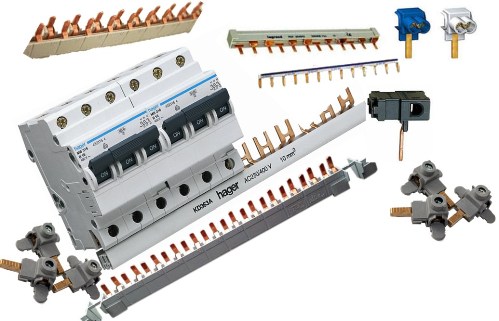
Distribution combs and input terminals
The pins at the comb are inserted into the clamp of the machine. The input terminal with its pin is wound here. To avoid misalignment of the comb, the terminal pin is placed under the comb pin on machines with a movable lower part of the clamp. When the clamp does not have a moving part, the terminal pin is placed above the comb pin. Wires are connected to the input terminal.
The use of distribution combs is not a requirement. Many masters make installation with flexible wires, compressing their ends with special tips. Such a scheme turns out to be quite working, but it takes up quite a lot of space, and it is difficult to understand piles of wires.
To connect PE protective zero, a special earth bus is used, which is located near the input of the bulk of the cables. In all cases of placement in the shield of the phase bus “L” and the working zero “N”, it is necessary to use insulated cases for them.
Electric power input cables are usually run into the shield through the top or side mounting holes, and load power cables from the bottom. All cables and wires must be clearly marked and marked. Thoughtful and neatly made cable management saves space in the switchboard and allows electricians to quickly deal with the installation of the circuit during its operation.
Before commissioning after installation, before connecting to voltage, it is necessary to conduct an external and internal inspection of the installed equipment and measure the insulation resistance of the assembled circuit.
A new shield must be maintained. For this, after six months of operation, it is required to carry out a control broach of all threaded connections and contacts, and then check them once a year. And do not forget to check the RCD with the "Test" button at least monthly.
See also at bgv.electricianexp.com
:
